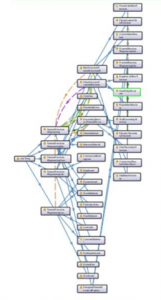1. Introduction
In today’s complex and ever-changing field of civil engineering, there are numerous factors involved in the design, analysis and construction of buildings, of which the selection and modeling of structures is a crucial aspect. Frame structures have significant advantages in the field of civil engineering, their strong structural stability, flexibility and economy make them ideal for a wide range of building and infrastructure projects, so creating an ontology for use in frame structure engineering is necessary, which is why I chose frame structures.
2. Purpose and Scope
Defining a clear objective and scope, and clarifying the purpose of the ontology is key to ensuring that the modeling process is relevant. At the same time, the practical use of the ontology is taken into account to make the ontology tangible. With this thorough preparation, the ontology development process will be smoother and more efficient, ensuring that the final ontology built meets expectations and is feasible for practical application.

3. Building an Ontology
3.1 List key terms within the ontology
The importance of enumerating key terms in an ontology is to create a clear and structured frame work that defines the concepts and the relationships between them. This not only helps to understand the underlying knowledge structure, but also ensures a precise understanding and application of the ontology model. By enumerating the key terms, a foundation is laid for effective and consistent knowledge management.
- Physical components: For frame structures, these are usually divided into two main subcategories, primary and secondary structures, with the primary structures being beams, slabs, columns, and foundations, and the secondary structures walls, stairs, and elevators
- Primary Materials: Although most materials can be of many types, this category primarily defines the primary materials of a frame structure, i.e., the materials of the major structural components.
- Loads: For a structure to carry a variety of loads, the types of loads are listed here, and the combination of loads needs to be further analyzed based on the requirements of the structural design.
- Use: The use of the frame structure will affect the configuration of each structural component, and its scope of application needs to be considered according to the actual situation.
3.2 Define the classes and the class hierarchy
For this ontology construction, a top-down development approach was chosen, starting with the most generic concepts and then specializing concepts from that domain. The frame structure project was set up as a generic concept, and then some subclasses were created to specialize it, specific subclasses were main components, materials, use, and loads.

In the end, the following figure shows the final result of this ontology modeling.

4. Engineering Example
Structural design of a multi-story office building:
Scenario: a new multi-storey office building is planned for which a structural design is required to ensure its safety and sustainability.
Use case: The ontology provides information about the structural elements of a multi-storey building, such as beams, columns and floor slabs, as well as possible building materials and connections. Designers can use the ontology to create a structural model of the building and verify its stability through structural analysis.
Downloadable Content
Full Report: Jianwen Wang